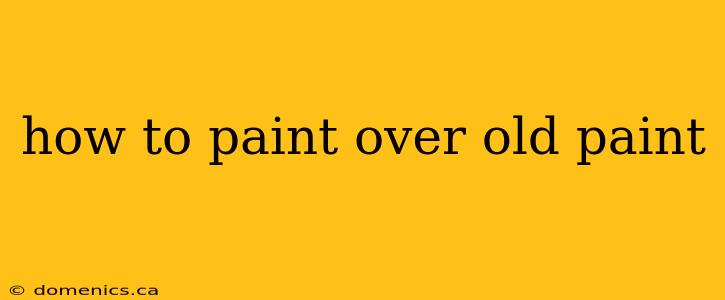Meta Description: Learn how to paint over old paint like a pro! This comprehensive guide covers surface prep, choosing the right paint, application techniques, and troubleshooting common problems. Get a flawless finish every time.
Introduction: A Fresh Coat for Your Walls
Painting over old paint is a common home improvement project. It's a fantastic way to refresh a room's look and feel. However, success hinges on proper preparation. This guide will walk you through each step, ensuring a professional-looking finish. We'll cover everything from surface preparation to choosing the right paint and application techniques. By following these steps, you can successfully paint over old paint and achieve a beautiful, long-lasting result.
Assessing Your Walls: The First Step to Success
Before grabbing your brushes, assess the existing paint. Is it glossy, matte, or somewhere in between? Knowing the type of paint is crucial for choosing the right primer (discussed below).
Inspect for Problems: Check for cracks, peeling paint, or any damage to the surface. Addressing these issues before you start painting is essential. Repair any holes or cracks with spackling paste and sand smooth. If there's significant peeling, you may need to scrape and remove the loose paint completely.
Surface Preparation: The Key to a Smooth Finish
This step is often overlooked but is the most crucial aspect of painting over old paint. Neglecting this leads to uneven surfaces and poor paint adhesion.
Cleaning the Walls:
Thoroughly clean your walls to remove dust, cobwebs, grease, and dirt. Use a damp sponge or cloth, and ensure the walls are completely dry before proceeding. For heavily soiled areas, consider using a mild detergent solution.
Priming the Walls:
Priming is critical, especially when painting over glossy surfaces or dark colors. Primer ensures better adhesion and prevents the old paint from bleeding through your new coat. Choose a primer compatible with your existing paint type and the new paint you’ll be using.
- Oil-based primer: Works well on glossy surfaces and helps to seal stains.
- Water-based primer: Easier to clean up but might not be as effective on glossy surfaces.
Apply the primer evenly using a roller or brush, allowing it to dry completely before applying the paint.
Sanding (If Necessary):
If you're dealing with a heavily textured surface or glossy paint, light sanding can help create a better surface for the new paint to adhere to. Use fine-grit sandpaper (120-220 grit) and sand gently to avoid damaging the surface. Wipe away the dust with a tack cloth before proceeding.
Choosing the Right Paint: Quality Matters
Select a high-quality paint appropriate for your walls. Consider these factors:
- Paint Type: Latex paints are generally the best choice for interior walls. They are easy to clean up, durable, and offer a wide range of colors.
- Finish: Matte, eggshell, satin, and semi-gloss are all options. Matte hides imperfections best, while gloss is most durable and easy to clean. Consider the room's function when choosing a finish.
- Color: Select a color that complements your decor and lighting. Use a paint swatch to test the color in different lighting conditions before committing to a full can.
Painting Techniques: Achieve a Professional Look
With your prep work complete, it’s time to paint. Here's how to get a smooth, even coat:
- Cut in the edges: Use a paintbrush to paint a 2-3 inch border around the edges of the walls, along the ceiling, trim, and corners.
- Roll the walls: Use a high-quality paint roller with a nap appropriate for your wall texture. Apply the paint in even, overlapping strokes.
- Apply multiple coats: Allow each coat to dry completely before applying the next one. Two coats are typically needed for optimal coverage.
Troubleshooting Common Problems
Even with careful preparation, issues can arise.
Paint Bleeding: If the old paint bleeds through, you likely need a better primer or more coats. Use a stain-blocking primer to prevent further bleeding.
Uneven Finish: Uneven surfaces can cause an uneven finish. Make sure to properly sand any bumps or imperfections before painting.
Roller Marks: Use a high-quality roller and apply even pressure to avoid roller marks.
Conclusion: A Fresh Look, Effortlessly Achieved
Painting over old paint can be a rewarding DIY project. By following these steps, paying close attention to surface preparation, and using quality materials, you can achieve a professional-looking, long-lasting finish. Remember, the key is thorough preparation – it makes all the difference! Now go ahead and refresh your space with a brand-new coat of paint!
